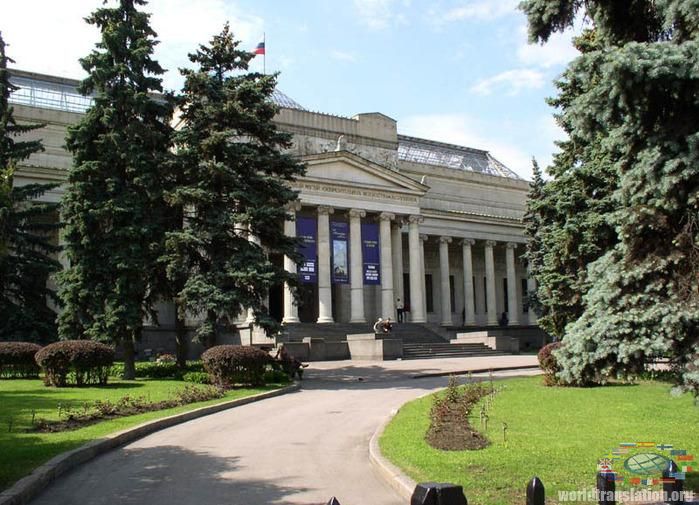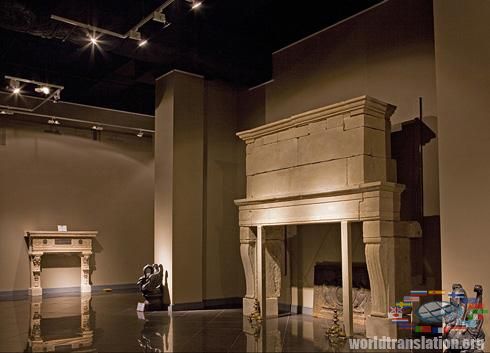Museum of fine art on Volkhonka (Moscow, Russia)

Tsvetayev organized gathering of the private donations, to construct a museum building and create a fund for building collections . The rich merchants and industrialists gave money, considering it an honor to take p art in this noble cause. A huge sum in those days - 2 million rubles, more than anyone else, donated Yuriy Stepanovich Nechaev-Maltsev, owner of the glass factories. A famous architect - Roman Ivanovich Klein was invited for the construction of the museum building. In 1899 was held the ceremonial laying of the museum, which took place on an ancient street Volkhonka in Moscow. Since then, muscovites followed how gradually growing a neat building, decorated with columns in Greek style, gaining more and more definite shape. Finally, it was crowned by the an unusual for that time glass roof, which was developed by outstanding design engineer Vladimir Grigorievich Shukhov. And when, after the grand opening, the first visitors entered the building, they were met by a magnificent staircase made of pink marble.
At first the museum, which has to become one of the most famous museums in the world, was conceived as a training and educational center of Moscow University. And the plaster casts of famous sculptures from antiquity to the Renaissance were the basis of its collections. Visitors can see as the goddess of victory Nike of Samothrace, the original of which is stored in the Louvre, as copies of the sculptural masterpieces of Michelangelo. Among them was a masterpiece of masterpieces - a huge marble statue of David, the biblical hero who defeated the giant Goliath. The original of it is stored in Florence, the great master has created it in 1501. In addition, since the foundation, in the new Moscow Museum was placed the rich "Egyptian" collection of authentic monuments of culture and art of ancient Egypt belonged to the famous scientist, egyptologist Vladimir Semenovich Golenishtchev. They were collected in the 80s of the XIX century, when a scientist at his own expense held archaeological excavations in Egypt.
In addition, since the foundation, in the new Moscow Museum was placed the rich "Egyptian" collection of authentic monuments of culture and art of ancient Egypt belonged to the famous scientist, egyptologist Vladimir Semenovich Golenishtchev. They were collected in the 80s of the XIX century, when a scientist at his own expense held archaeological excavations in Egypt.
But if in the early years, museum could show visitors only exhibits relating to ancient Egypt and plaster casts of sculptural masterpieces, then progressively in the palace at Volkhonka was gathered a fine collection of Western European and World painting and genuine sculpture of XIII-XX centuries. Made of well-known private collections of Russian collectors, and a number of paintings was transferred to the museum by the Hermitage.
With the initial collections gathered by Tsvetaev - plaster casts of many famous sculptures, visitors can meet today. Also with the huge "Egyptian" collection of Golenishchev. The museum exposition is built in such a way, that a long journey to the Palace of Arts on Volkhonka usually begins with it. Even the interior of the Hall of Ancient Egypt is executed in the style of ancient Egyptian temple: to the bright painted ceiling rising columns which looks like bundles of papyrus stalks. One of the stored here masterpieces is - statue of the pharaoh Amenemhet III in black granite. It was the Pharaoh of the XII dynasty, who ruled in the II millennium BC. And among other things are: opened by the Golenischev during the excavations: wall reliefs, sarcophaguses, mummies, amulets, wooden figurines, faience vessels, jewelry of the Egyptian fashionistas.
But most of the rooms of the museum are now occupied by a pictures: here you can see masterpieces of Veronese, Rubens, Boucher, Rembrandt, Murillo, Poussin, Corot, Chardin, and many other masters.  A special section of the museum - the most valuable collection of works by French Impressionists. This area of painting which arose in France in the last third of the XIX century, got its recognition not immediately. Initially scattered spots of color, blurred contours of depicted objects on the impressionists paintings caused confusion in public, which was educated on the classical samples.
A special section of the museum - the most valuable collection of works by French Impressionists. This area of painting which arose in France in the last third of the XIX century, got its recognition not immediately. Initially scattered spots of color, blurred contours of depicted objects on the impressionists paintings caused confusion in public, which was educated on the classical samples.
In the end, the names of these artists have become famous: Claude Monet, Auguste Renoir, Edgar Degas, Camille Pissarro, Edouard Manet, Paul Cezanne. But just when they were young, unheralded and unrecognized, their works eagerly bought many Russian collectors of art, while they being in Paris, showing thus a fine intuition. Among these collectors were, for example, entrepreneurs M.A. Morozov and S.I. Shchukin. Now collected by them Impressionist paintings are exhibited in the Pushkin Museum.
However, the museum is not only famous for its collections, but also a surprising charm, under which certainly falls everyone. Who has once visited it, always will remember the Hall of Ancient Egypt, which looks like the temple, and, of course, a magnificent hall, called the Italian garden.
Here in the casts a monumental sculpture of the Renaissance period is presented, and among it a masterpiece of masterpieces - the statue of David by Michelangelo. A horse statues of condottieries, as were called the leaders of wage military units in the service of Italian nobles, an exact copy of the portal of the German city of Freiberg cathedral decorated with sculptures, and a soft light pouring through the ceiling glass windows-plafonds , give this room a special romantic look.
Italian courtyard is located in the he art of the museum, so you can visit it some times to get some rest .
Video: "Pushkin Museum"